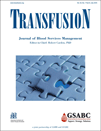Absence of acute adverse in-vitro effects on AS-1 RBCs and whole blood–derived platelets following prolonged exposure to 13.56 MHz radio energy
Address reprint requests to: Jerry Holcombe, Blood Center of Wisconsin, 638 North 18th Street, Milwaukee, WI 53233; e-mail: [email protected].
This study was supported, in part, by grants from the National Institutes of Health (NIH) and the Foundation for America's Blood Centers (FABC). There are no conflicts of interest.
Abstract
BACKGROUND: There is growing interest in radio frequency identification (RFID) technology application for tracking blood products to achieve higher productivity and safety in the transfusion medicine supply chain. We have conducted a limited study to assess the temperature and biological effects of 13.56 MHz RF radiation on RBCs and whole blood–derived platelets (WBDP) under extreme exposure conditions.
STUDY DESIGN AND METHODS: Using an FDA-approved protocol, test units of both RBC and WBDP were subjected to approximately 100 watts of RF energy for an extended duration (23-25 h) to assess worst-case effects. Three replications of the test were performed.
RESULTS: Hemolysis after 23-25 hours of RF energy exposure was 0.09% and 0.05%, respectively, for TEST and CONTROL RBC units and well within the ≤1% limit in the FDA-approved acceptance criteria. For WBDP units, the mean pH of TEST and CONTROL units were 7.27 and 7.19, respectively, following 23-25 hours of RF energy exposure, and well above the ≥6.2 acceptance limit. Further, there was no detectable acceleration in cellular degradation of RBC and WBDP products. While there was minimal temperature rise, the relative temperature increase between TEST and CONTROL units never exceeded the 1.5°C acceptance criterion.
CONCLUSIONS: 13.56 MHz-based RFID technology is unlikely to have any significant temperature or biological effects on RBC and WBDP units under the normal operating conditions (a maximum of 4 watts RF power exposure for about 20 nonconsecutive minutes for RFID tracking during the life of the blood product).




